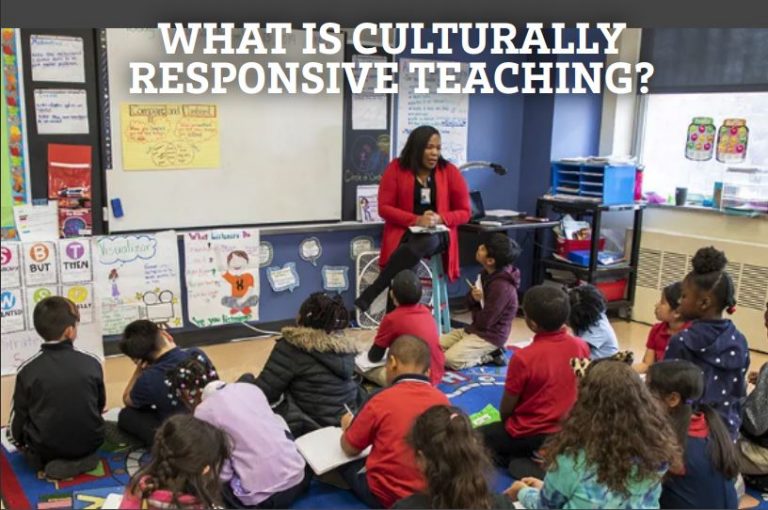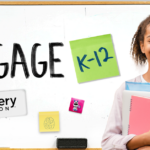This article was originally seen on Curriculum Associates’ blog and published in the March, 2021 issue of Equity & Access.
All students deserve equitable opportunities to learn. Culturally responsive teaching gives educators the tools to not only be equitable in their instructional practices but to also validate and affirm students’ identities and engage them on that basis. However, there’s a great deal of confusion in the education world about culturally responsive teaching. What does it mean exactly? How does it help students learn? How can educators implement culturally responsive teaching in their classrooms?
In this introductory explainer post, we explore what culturally responsive teaching is not, what it is, and how it can transform instructional practices.
Culturally Responsive Teaching Is Not . . .
A Set of Prescriptive Actions
It’s not simply about celebrating Black History Month, putting quotes from Black, Indigenous, and People of Color leaders, artists, athletes, and politicians on your classroom walls, nor is it even just about developing a specific set of skills. As Dr. Sharroky Hollie, Executive Director of The Center for Culturally Responsive Teaching and Learning, says culturally responsive teaching must start with a change in mindset (i.e., beliefs, attitude, biases, etc.) before a change in skillset (i.e., practices, habits, training, etc.).
Just about the Content
The term “content” could refer to materials, curriculum, themes, or objectives that guide a class. Diverse or multicultural content is necessary, but, by itself, it is not enough to ensure cultural responsivity. Let’s break that down.
First, diverse texts and classroom resources are important. We want to be very clear about that. According to Dr. Gholdy Muhammad, the author of Cultivating Genius: An Equity Framework for Culturally and Historically Responsive Literacy, “We have to ask what texts can help our students accomplish. Texts should drive cognitive goals (skills and intellect) as well as critical analysis (criticality) and sociocultural goals (identity).” Whenever possible, educators should choose texts that reflect students’ lives or expose them to lives unlike their own (these are known as “mirror” and “window” texts, respectively).
Second, having diverse texts in the classroom library does not automatically make that classroom culturally and linguistically responsive. For that to happen, teachers must also use instructional and classroom-management practices that consider and then draw on beliefs and behaviors from students’ home cultures.
A Change from “Bad” to “Good”
Culturally responsive teaching asks educators to reimagine their classrooms, not throw out every practice they’ve been using or activity that has been successful. While change is required, culturally responsive teaching practices can build on “good” practices already in place. In fact, many of these practices will be familiar to educators (e.g., speaking with physical gestures, facilitating discourse, and using a variety of voluntary and nonvoluntary response protocols). What’s different is that the strategies behind them are fueled by the belief that diversity is an asset and the practices themselves consistently communicate teachers’ high expectations for all students. Excellence is always the goal.
Culturally Responsive Teaching Is . . .
A Mindset
As mentioned above, the culturally responsive teaching journey starts with educators’ willingness to examine and challenge their own worldviews, biases, and habits. While educators will start their journeys at different entry points, they must believe that all their students will succeed, and they must clearly communicate that belief to those students.
In Culturally and Linguistically Responsive Teaching and Learning: Classroom Practices for Student Success, Dr. Hollie writes, “[culturally responsive teaching] is rooted in seeing and feeling the change for yourself . . . you can see the difference without any external endorsement or research because you know that it feels right.”
Asset-Based
In an asset-based classroom, diversity in thinking, background, learning style, and culture are seen as not only positive but necessary. Differences are embraced as strengths rather than problems that need to be solved. Culturally responsive teaching focuses on what students can do and what they each uniquely contribute to the class dynamic.
Furthermore, in culturally responsive classrooms, educators recognize students’ home cultures and languages as assets for learning by intentionally drawing on them to shape curriculum, instruction, and classroom management. With time, culturally responsive classrooms take on a different look altogether. They become collectivist in nature—dynamic spaces where students not only learn from the teacher (and vice-versa), but they also learn from one another.
An Engagement Strategy
Dr. Hollie likes to tell educators who seem overwhelmed by culturally responsive teaching to think of it as a strategy for engaging all students. When students are validated and affirmed, they are more likely to feel recognized, valued for their contributions, and eager to learn. When educators put students’ ideas at the center of instruction, they signal that they respect and value students’ thinking.
Relationship-Centered
Relationships are one of the cornerstones of culturally responsive teaching. In fact, culturally responsive teaching cannot happen without strong teacher–student relationships, as educators need to get to know their students
individually in order to understand each student’s culture and values. With time, the trusting relationships students have with their educators should extend to families and community members.
Success-Focused
High expectations signal to students that their teachers believe in them and their ability to learn. Students who meet high expectations gain self-esteem and develop a growth mindset, which is the understanding that learning and achievement come from effort and practice rather than inherited and fixed personal characteristics. To close the opportunity gap and make real progress in addressing the harm caused by systemic racial inequities in education, teachers need to believe that their historically underrepresented students can master the same rigorous content as their dominant-culture peers.
Developing a culturally responsive instructional practice takes time, but the proven benefits (e.g., increased engagement, learning gains, deeper relationships, etc.) are worth it.
When teachers put students at the center of all instruction and when they give marginalized students an equitable education experience—that is the essence of culturally responsive instruction.
The American Consortium for Equity in Education, publisher of the "Equity & Access" journal, celebrates and connects the educators, associations, community partners and industry leaders who are working to solve problems and create a more equitable environment for historically underserved pre K-12 students throughout the United States.
- American Consortium for Equity in Educationhttps://ace-ed.org/author/admin/
- American Consortium for Equity in Educationhttps://ace-ed.org/author/admin/April 23, 2025
- American Consortium for Equity in Educationhttps://ace-ed.org/author/admin/
- American Consortium for Equity in Educationhttps://ace-ed.org/author/admin/







